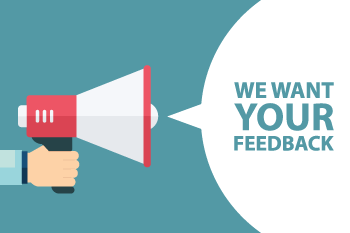How HR Can Help Employees Be More Productive
By Mike Raia ![]() | Published January 28, 2020
| Published January 28, 2020
How would you rate productivity at your company?
-
Are orders consistently going out on time?
-
Are clients satisfied with your services or products?
-
Are you growing in relation to your competitors?
-
Are projects frequently running over?
If not, you could have systemic productivity problems. These issues may be due to company culture, outdated processes, unoptimized workflows, inconsistent hiring, or poor onboarding processes. The good news is that these things can be fixed and your employee morale, job satisfaction, engagement, and employee productivity can be improved.
 Provide Employees with Feedback Outlets
Provide Employees with Feedback Outlets
Providing effective feedback outlets is essential for both customers and employees. In the past, feedback outlets were called suggestion boxes. Today, the suggestion box is more likely to be a piece of software that is designed to collect and sort ideas so that they can be effectively managed and potentially implemented. The goal of feedback outlets is to make employees feel valued, which increases their morale, productivity, and engagement. In fact, when employees are actively engaged with the company, businesses report an increase in productivity of up to 22 percent and a reduced turnover rate of between 25 and 65 percent, according to the Harvard Business Review.
When feedback outlets are properly implemented through idea management software, an employee submits an idea, either anonymously or with their name attached. Then, management reviews the idea and passes it on to other individuals within the organization so that they can add their feedback and ideas to the original suggestion. If the idea is deemed useful, steps are taken to implement it. Once the idea is implemented, the employee knows that their employer listened to them, feels valued and is more likely to offer future suggestions, engage with other employees and management and perform their job better.
 Promote Collaboration
Promote Collaboration
How many times have you heard an employee tell you that they cannot get that report to you because someone else hasn’t provided their piece of the information? When you hear this scenario, it should tell you that collaboration between employees and departments isn’t working effectively.
Take an objective look at employee workflow. When workflows are running optimally, employees can communicate and share information effectively. This reduces miscommunication between employees, project delays, redundancy, and the need for redoing work that was completed incorrectly.
Optimizing a workflow starts with documenting the process, then breaking that process down into tasks. Once the visual representation of the process has been created, HR, management and executives can review that process and add their own input until consensus has been reached. Then, the process is can be built in a process automation solution and implemented.
Once implementation has taken place, employees can quickly see where items are in the process and where potential problems are occurring. For example, if an employee needs to request a change in their benefits due to a change in their family status, they should be able to log into a benefits portable, request the change and submit any required paperwork. This process eliminates the need for the employee to visit HR in person, which increases productivity for both the human resources manager and the employee. Once the request has been submitted, the HR benefits manager should receive an alert, which could be via email or through a notification on their business cell phone. At that time, HR can review the request, ask for more information and either approve or deny the request.
The workflow process allows the employee and HR to quickly see where the benefits change request is in the process, which is essential if delays are experienced. For example, if the normal approval time is five days, and HR and the employee noticed that it’s been seven days, they can look in the system to see where the request is delayed. In this scenario, it could be because the HR manager has not reviewed the request or the HR manager is waiting for more information before approving the request. Once the reason for the delay is known, steps can be taken to reduce delays, such as sending employees periodic notifications on the need for more paperwork or sending the HR manager notices that they have pending requests.
 Improve Employee Experience and Morale
Improve Employee Experience and Morale
Improving the employee experience at work can improve morale, which leads to better engagement and higher levels of productivity. For HR, this can mean reducing instances of some of the most common employee complaints, including failing to recognize employee achievements and successes, not providing constructive criticism or providing a pathway to advancement and instances of supervisors and managers refusing to talk to subordinates via email, phone calls, and in-person meetings.
In fact, employees don’t tend to quit jobs. They quit bosses. It’s estimated that up to 17 percent of the individuals who recently quit a job left because of a toxic boss, according to Inc. However, when a closer look at the reasons and stats are performed, bad management actually accounts for up to 75 percent of the reasons employees leave. Lack of promotional opportunities and career advancement account for 32 percent of the reasons cited by past employees, pay and benefits were listed 22 percent of the time and not a good fit for the job was listed 20 percent of the time.
This means that improving the employee experience and morale may be as easy as making sure managers are properly onboarded and trained. For existing managers, it may mean retraining in order to ensure that communications are effective and promotions are being handed out according to predefined metrics, not favoritism.
By ensuring that the managers, supervisors, and bosses at your company are encouraging and effective instead of toxic, the employee experience and company culture improve and productivity and employee engagement increases. This is because employees call out sick less.
In companies where workplace stress is high, medical expenses and insurance claims due to stress-related illnesses are 50 percent higher than for companies that maintain a low-stress environment, according to the Harvard Business Review. Further exemplifying this is the fact that employees call out 37 percent more often when the work environment is toxic and workplace accidents increase by up to 49 percent, which means more workers compensation claims.
 Implement Consistent, Effective Onboarding
Implement Consistent, Effective Onboarding
Consistent, effective onboarding can mean the difference between hiring employees that are not a good fit for your company or the job and hiring the best employees for the job and your company culture. In fact, making a bad hiring decision can cost as much as 50 to 60 percent of that employee's yearly salary, according to Alvernia University.
When it comes to effectively hiring and onboarding new employees, it’s important to completely explain daily work life, the expectations, the company culture, and the advancement opportunities and what to expect long-term. The process of company culture explanation should start with the job advertisement and continue during the interview process. Additionally, all potential employees should go through the same process, regardless of the position. This means that all the qualified resumes should be reviewed along with any required assessment tests. Good candidates should be interviewed and potentially skills tested, according to the requirements of the position. If two or more candidates are similarly qualified, then second and third interviews may be needed.
To ensure the process is as accurate and smooth as possible, automation can be used in order to store and review resumes and assessment tests and to hold interview questions and answers and overall impressions from the interviewers. This ensures that each candidate is treated fairly and that the hiring process is not biased in any way.
Once the right candidate has been hired, the onboarding process starts with initial hire paperwork. This can be delivered online, which helps improve the accuracy and efficiency of the new hire process. Employee guides and training manuals can also be distributed to the new employee prior to their first day so that they know what to expect.
When it comes to training, it’s important to utilize online training software to ensure all the needed information is learned before beginning on-the-job training, which can last anywhere from one to six months. The good news is that 90 percent of new hires make the decision to stay during the first six months of their employment. If an employee decides to leave the company, it’s usually done within the first month and a half after being hired.
 Remove Barriers to Productivity
Remove Barriers to Productivity
To ensure great employee retention and high productivity, it’s important to understand the three most common barriers that decrease productivity, including having outdated processes, inefficient or improper technology, and being resistant to change. When employees are constantly fighting with their computers and outdated technology, they can’t be productive, and they tend to rapidly lose engagement when employees' suggestions and ideas are ignored. This can lead to a business that stagnates and even decreases instead of grows and changes with the times. Even if the business is able to maintain, it may still be falling behind when compared to its competitors.
Lastly, businesses and employees must always be open to change. This is because the world is not stagnant and technology is always improving, and there may be a better, more cost-effective way to do the things you’ve always done. Change and innovation start with ideas from new and existing employees and discussing those new ideas as a group in order to get feedback and further improve the idea. Once those ideas are implemented, new training protocols may be needed to ensure all employees are up-to-date on the new processes and using them.
When effective onboarding, employee and manager training, and idea innovation are utilized, employee productivity and morale increase. This is because employees feel as though they can and do make a difference in their jobs and with the company as a whole. When this happens, companies experience a lower rate of turnover, processes, and tasks require less time to perform and employees are less likely to call out sick or get injured while on the job.
Tags
HR human resources productivity Workflow
Categories
Department Focus Productivity Tips

Mike Raia
Marketing the world's best workflow automation software and drinking way too much coffee. Connect with me on LinkedIn at https://www.linkedin.com/in/michaelraia/